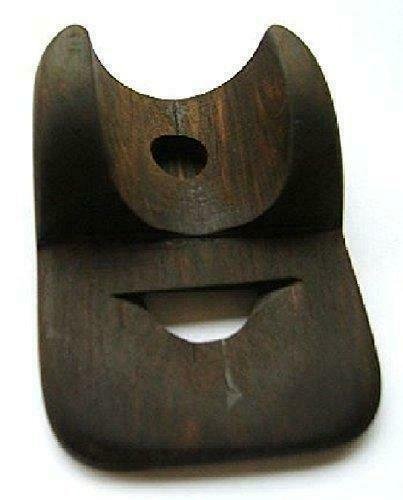Ethical Amazon Samba Nose Whistle Dark Ethnic Unusual Tribal Music Instrument







Item Description
Wooden Humanitone
Wooden Humanitone / Nose Whistle made from a solid single piece of wood.
Extremely versatile instruments used by Yagua Indians in Brazil.
Used to make a wide variety of exotic bird calls. they were also used communicate news through the rainforest.
They are carved from a single piece of wood.
The whistle is played by blowing air from the nose into the top hole while manipulating the tongue, lips and soft pallet to change the note while keeping an open mouth.
It's easier than it sounds and is great fun.
You can get cheap plastic versions of these whistles called humanatones but they are a rubbish imitation of the real thing which we have here.
Size 6cm
Please note due to the hand made nature of the product, actual design may vary slightly from those pictured but all are the same style.
We have lots of other woodwind instruments
This is not a toy - unsuitable for children
History
Nose whistles are traditionally used by various South American indigenous peoples of the Amazon rainforest, such as the Nambikwara. Representing fertility or of war some groups in Nambikwara, nose flute "that t達u su" in Nambikwaran was not used as a ritual tool, and often a childs toy. In the opposite Piaroa used the tool "Chuvo" in Wot誰ha tivene along with other flutes in ritual situations where he represented manhood, and played during the war. Despite their ethnic origins, the models were developed and patented in the 19th and 20th centuries. James J. Stivers, co-founder of Humanatone, is credited with coining the "Humanatone". The view from new York, hes whistling nose was made of tin plates. Today, whistles of the nose are often sold as childrens novelties and is made of plastic, while the enthusiasts are using to change the tools for more convenient use by adults, and better sound. Using wax to extend the Cup nose for adults large jaws is one of such methods
Acoustics
The nose blows the air into the tools open Cup of the nose, where it is directed through the duct in the direction of the sharp edge of the fipple, which is located above the players opening the mouth. The location of the edge helps to create a vortex which excites in the acoustic field in the players mouth. The pitch and tone changes then the musician through the movement of their mouth and tongue, and also by varying the air flow and, possibly, through a small hole in the plate for the tremolo. Since the oral cavity is the functional resonance chamber defining a tonality of the instrument, as opposed to the volume of the chamber is changed by the holes or buttons, like in the case of flutes and recorders, whistle nose produces tones along a glissando.
Payment
We require payment by paypal. All major credit and debit cards are accepted by paypal (no paypal account necessary). 
All our items are posted first class in the UK. We ship all items within 3 working days, usually faster.
We use recycled products where we can. All items are professionally packed.
All items are new unless stated.
Returns
Returns accepted within 30 days. Buyer pays return costs. There is a returns slip included with your item to make the process easier.
Please contact us on the email address provided on the slip if you have any questions.